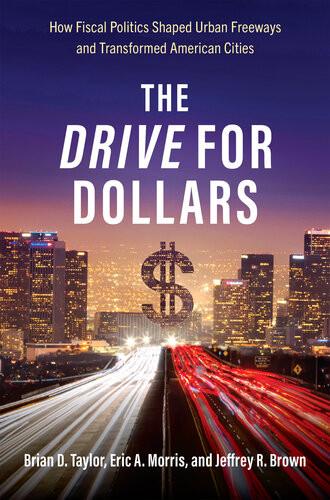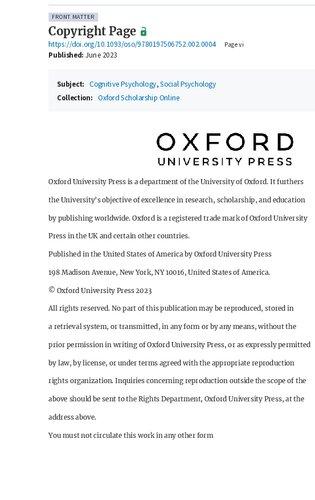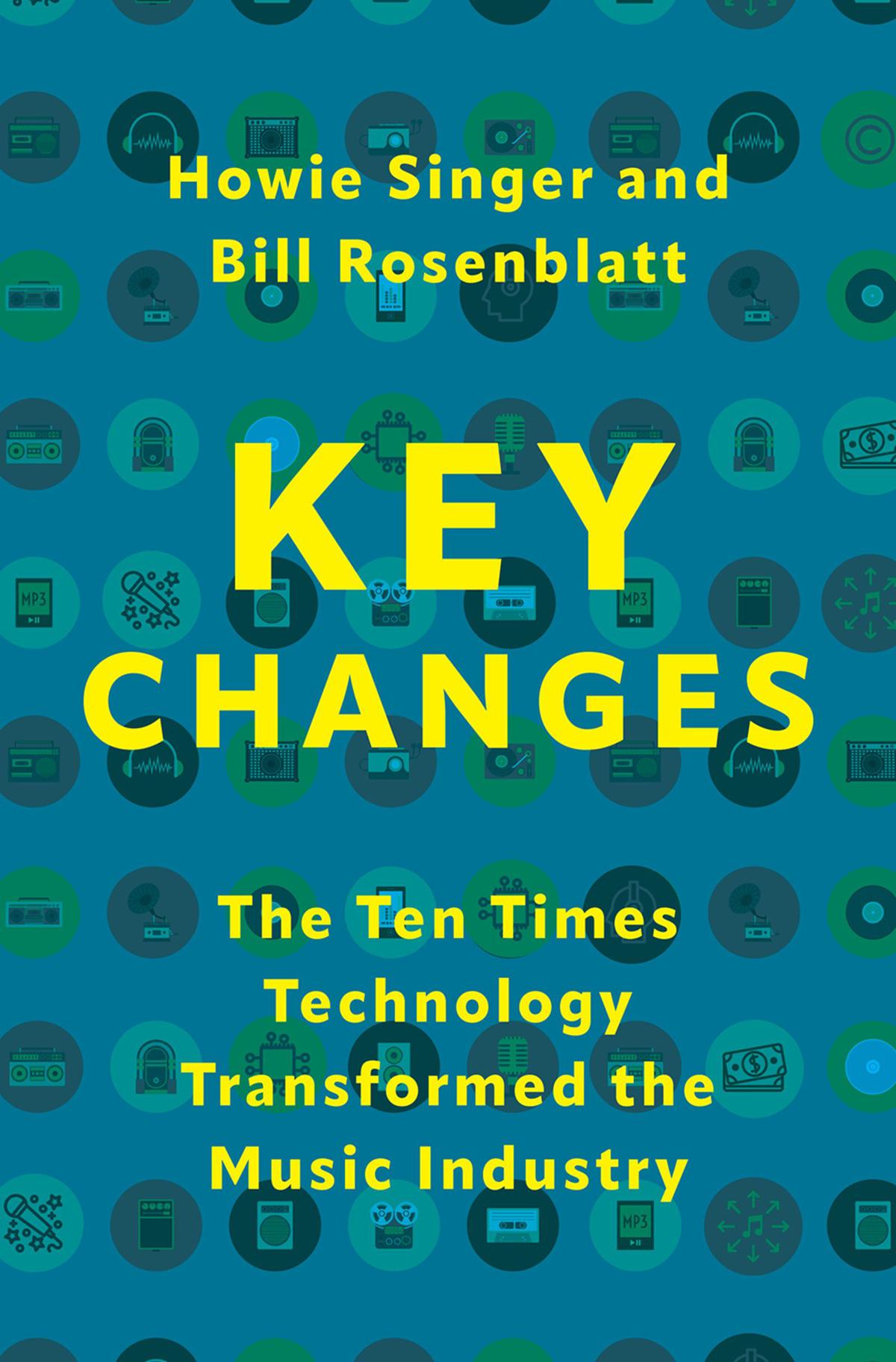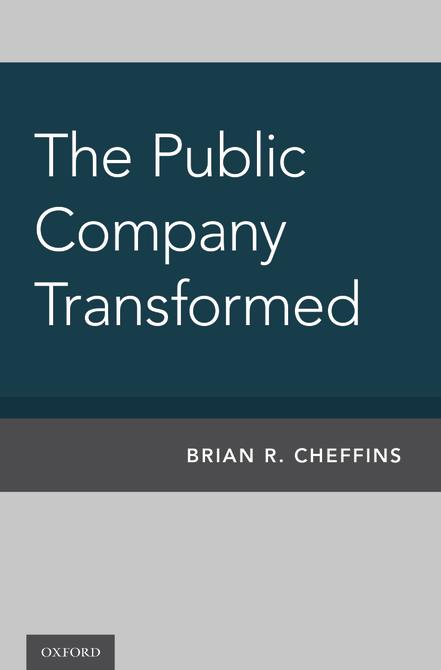The Public Company Transformed Brian
R. Cheffins
Visit to download the full and correct content document: https://ebookmass.com/product/the-public-company-transformed-brian-r-cheffins/

More products digital (pdf, epub, mobi) instant download maybe you interests ...

The Drive for Dollars: How Fiscal Politics Shaped Urban Freeways and Transformed American Cities Brian D. Taylor
https://ebookmass.com/product/the-drive-for-dollars-how-fiscalpolitics-shaped-urban-freeways-and-transformed-american-citiesbrian-d-taylor/

Company Men (The Bad Company Books Book 2) Adam Stemple
https://ebookmass.com/product/company-men-the-bad-company-booksbook-2-adam-stemple/

Chimpanzees, War, and History: Are Men Born to Kill? R. Brian Ferguson
https://ebookmass.com/product/chimpanzees-war-and-history-aremen-born-to-kill-r-brian-ferguson/

The Artifact Brian Hill
https://ebookmass.com/product/the-artifact-brian-hill/

The Betrayed Brian Hill
https://ebookmass.com/product/the-betrayed-brian-hill/

Complete Accounting for Cambridge IGCSE (R) & O Level
2nd Revised edition Edition Brian Titley
https://ebookmass.com/product/complete-accounting-for-cambridgeigcse-r-o-level-2nd-revised-edition-edition-brian-titley/

Mind Shift: How Culture Transformed the Human Brain
John Parrington
https://ebookmass.com/product/mind-shift-how-culture-transformedthe-human-brain-john-parrington/

The Nalco water handbook Fourth Edition Nalco Company
https://ebookmass.com/product/the-nalco-water-handbook-fourthedition-nalco-company/

Key Changes - The Ten Times Technology Transformed the Music Industry Howie Singer
https://ebookmass.com/product/key-changes-the-ten-timestechnology-transformed-the-music-industry-howie-singer/

The Public Company Transformed
The Public Company Transformed
Brian R. Cheffins
Public Company Transformed. Brian R. Cheffins.
Oxford University Press is a department of the University of Oxford. It furthers the University’s objective of excellence in research, scholarship, and education by publishing worldwide. Oxford is a registered trademark of Oxford University Press in the UK and certain other countries.
Published in the United States of America by Oxford University Press 198 Madison Avenue, New York, NY 10016, United States of America.
© Oxford University Press 2019
All rights reserved. No part of this publication may be reproduced, stored in a retrieval system, or transmitted, in any form or by any means, without the prior permission in writing of Oxford University Press, or as expressly permitted by law, by license, or under terms agreed with the appropriate reproduction rights organization. Inquiries concerning reproduction outside the scope of the above should be sent to the Rights Department, Oxford University Press, at the address above.
You must not circulate this work in any other form and you must impose this same condition on any acquirer.
Library of Congress Cataloging-in-Publication
Data
Names: Cheffins, Brian R.
Title: The public company transformed / Brian R. Cheffins.
Description: New York, NY : Oxford University Press, 2018. | Includes bibliographical references and index.
Identifiers: LCCN 2018018657 | ISBN 9780190640323 ((hardback) : alk. paper)
Subjects: LCSH: Corporation law—United States—History. | Corporations— United States—History.
Classification: LCC KF1414 .C475 2018 | DDC 346.73/066—dc23 LC record available at https://lccn.loc.gov/2018018657
9 8 7 6 5 4 3 2 1
Printed by Sheridan Books, Inc., United States of America
Note to Readers
This publication is designed to provide accurate and authoritative information in regard to the subject matter covered. It is based upon sources believed to be accurate and reliable and is intended to be current as of the time it was written. It is sold with the understanding that the publisher is not engaged in rendering legal, accounting, or other professional services. If legal advice or other expert assistance is required, the services of a competent professional person should be sought. Also, to confirm that the information has not been affected or changed by recent developments, traditional legal research techniques should be used, including checking primary sources where appropriate.
(Based on the Declaration of Principles jointly adopted by a Committee of the American Bar Association and a Committee of Publishers and Associations.)
You may order this or any other Oxford University Press publication by visiting the Oxford University Press website at www.oup.com.
List of Figures and Table ix
Preface xi
Acknowledgments xv
1. Introduction 1
The Public Company Transformed—A Brief Chronology 2
This Book’s Contribution 7
Iconic Public Companies Transformed 13
AT&T 13
General Electric 24
Overview of the Book 37
2. Managerial Capitalism 39
Key Features 40
The Rise of Managerial Capitalism 42
Financial Capitalism Emerges 42
Financial Capitalism in Retreat 45
When Did Ownership Separate from Control in Large Public Companies? 48
Why Did Ownership Separate from Control? 52
Business Logic 52
Other Variables 55
Managerial Capitalism in Operation 61
The “Core Fissure” in US Corporate Governance 62
How Much “Personal Gain”? 63
Other Goals? 68
What Constrained Management? 72
Internal Constraints 73
Boards 73
Shareholders 76
External Constraints 78
The Market for Corporate Control 79
Competitors 80
Unions 90
Regulation 93
3. The 1970s: Managerial Capitalism Sustained . . . But “Something Happened” 101
Continuity and Change 101
Were the Public Company’s Days Numbered? 104
Managerial Capitalism Falters 107
American Management Falling Behind? 108
The Conglomerate Crack-Up 111
Illicit Payments 115
Internal Constraints 119
Shareholders 120
Boards 126
Criticism 127
Ideas for Improvement 129
Board Reform Implementation 130
External Constraints 135
Regulation 135
Expansion 135
Momentum Halted 137
Deregulation 139
Unions 141
Competitors 143
The Market for Corporate Control 151
4. The 1980s: Managerial Capitalism Taken Over 155
Don’t Just Manage—Lead! 156
The Deal Decade 162
Takeovers 163
Leveraged Buyouts 167
End of an Era 172
Internal Constraints 180
Boards 181
Shareholders 186
Shareholders Move Up the Priority List 187
Explaining the Reorientation 191
Takeovers and Managerial Priorities 194
External Constraints 197
Regulation 197
Unions 199
Competitors 201
The Pressure Mounts 202
Why Did Competition Intensify? 205
The Public Company Executive in Transition 212
5. The 1990s: Gloom to Euphoria . . and Back 219
From Stagnation to Overdrive to Hangover 223
America Falling Behind? 223
Rallying 225
Overdrive 226
Hangover 233
Internal Constraints 234
A Governance Vacuum 234
Boards 237
Shareholders 240
Shareholder Value Tops the Priority List 240
Shareholder Activism 242
The Quarterly Earnings Obsession 247
External Constraints 252
Unions 253
Regulation 254
Competitors 258
“Speed Is of the Essence” 258
Why the Pressure Intensified 261
The CEO as Corporate Icon 267
6. The 2000s: The Decade from Hell 277
Changing Circumstances for the Public Company 277
The Public Company’s Challenges 281
Corporate Scandals 281
SOX 289
Private Equity 296
The Financial Crisis 302
Internal Constraints 305
Boards 307
Shareholders 310
The Earnings Fixation Continues 311
Mainstream Institutional Shareholders 312
Hedge Fund Activism 314
External Constraints 318
The Market for Corporate Control 319
Unions 320
Regulation 322
Competitors 323
The Retreat of the Iconic Chief Executive 326
Banks, Their “Free Pass,” and the Financial Crisis 331
7. The Future of the Public Company 343
Extinction of the Public Company? 345
What’s New? 345
Private Equity 347
Unicorns and IPOs 349
The Public Company Retains Center Stage 355
The End of the Berle-Means Corporation? 358
Internal Constraints 362
Boards 363
Shareholders 367
Managerial Priorities 367
Hedge Fund Activism 370
Mainstream Institutional Shareholders 374
External Constraints 381
Unions 381
Regulation 382
Competitors 387
What Does the Future Hold for Public Company Executives? 393
CEO/Founders 394
Return of the Imperial CEO? 395
Embattled? 396
Managerial Capitalism Redux? 398
Index A General 403
Index B Authors 421
Index C Corporations and Other Business Enterprises 425
Index D People (Other Than Authors) 429
List of Figures and Table
Figures
1.1 General Electric Share Price, 1981–2001, Adjusted for Splits and Dividends, $ 33
2.1 US Corporate Stock Held by Households and Institutions, 1950–1970 77
3.1 US Corporate Stock Held by Households and Institutions, 1970–1980 121
4.1 Number of IPOs, 1970–1989 160
4.2 Public Company Takeover Bid Targets, 1955–1989 (# and aggregate value, $1987) 163
4.3 Divestitures of Subsidiaries & Divisions, 1955–1989 (# and aggregate value, $1987) 168
4.4 LBOs as a Proportion of Completed M&A Transactions, 1987–1999 172
4.5 Horizontal, Vertical, and Unrelated Acquisitions of US Companies, 1966–1989 176
4.6 S&P 500 Index, 1973–1991 (Opening Prices, monthly) 186
4.7 Share Buy-Back/Earnings, US Public Companies, 1972–1991 189
4.8 Strike Activity, 1950–1990 (# involving 1000 or more workers) 200
5.1 S&P 500 Index, 1990–2002 (Opening Prices, monthly) 224
5.2 Number of Listed Companies, 1990–1999 228
5.3 S&P 500 Index/NASDAQ, 1990–2002 (Opening Prices, monthly) 230
5.4 M&A Activity (Number and Value of Deals), 1985–1999 236
5.5 US Corporate Stock Held by Households and Institutions, 1980–1995 243
6.1 S&P 500, 2000–2009 (Opening Prices, monthly) 279
6.2 Number of Listed Companies, 1999–2009 279
6.3 Confidence in Big Business, 1993–2009 280
6.4 Americans Thinking That Investing in the Stock Market Was a Bad Idea, 1999–2003, percent 290
6.5 Number of IPOs, Large Firm/Small Firm, 1999–2009 294
6.6 Cash Distributions by Public Companies, 2000–2010 (constant 2012 dollars) 317
6.7 S&P 500/S&P 500 Banks, 2000–2009 335
7.1 Number of Listed Companies, 2008–2016 346
x List of Figures and Table
7.2 Number of IPOs and Aggregate Proceeds, 1990–2017 350
7.3 Stock Market Capitalization/GDP, Percent, 1975–2015 356
7.4 Confidence in Big Business, 2009–2017 357
Table
6.1 Corporate “Super Scandals,” early 2000s 283
Preface
The Public Company transformed is a book about the history of the American public company, focusing on the period running from the mid-twentieth century through to the present day. Though the book is historical in orientation, the origins of this project were not. The departure point was a 2009 article in which I investigated the functioning of corporate governance during the 2008 financial crisis through case studies of the 37 companies removed from the S&P 500 stock market index in 2008.1
In my S&P 500 article I introduced readers to the key corporate governance mechanisms in public companies, describing in so doing the roles these mechanisms would ideally play. I drew upon history to do this, as past developments illustrate effectively the corporate governance challenges public companies pose and reveal the logic underlying the “fixes” that have evolved. This facet of my S&P 500 project set me on the path that culminated in this book. As I looked backward when researching the core governance features of public companies, I quickly discovered that in the voluminous literature on American corporate governance, historical analysis was thin. Nevertheless, I persevered with my plan to use history to introduce readers to corporate governance challenges and fixes.
Having become aware through my S&P 500 project that the history of corporate governance was under-researched, I continued to explore the topic. Various publications ensued.2 As my research progressed I formulated a plan to write a book on the history of corporate
1 Brian R. Cheffins, Did Corporate Governance “Fail” during the 2008 Stock Market Meltdown? The Case of the S&P 500, 65 Bus. Law. 1 (2009).
2 The History of Modern US Corporate Governance (Brian R. Cheffins ed., 2011); Brian R. Cheffins, The History of Corporate Governance, in The Oxford Handbook of Corporate Governance 46 (Mike Wright, Donald Siegel, Kevin Keasey & Igor Filatotchev eds., 2013); Brian R. Cheffins, Delaware and the
governance. My idea was to focus on the United States because this was where, in the 1970s, managerial accountability issues were first considered by reference to the now ubiquitous “corporate governance” nomenclature.
A theme I emphasized in my writing on the history of corporate governance was that changes affecting public companies did much to account for corporate governance’s rise to prominence in the 1970s and to explain how corporate governance evolved in subsequent decades. As I developed this insight, it became evident there was a paucity of historically contextualized research on changes US public companies underwent from the middle of the twentieth century through to the present day. This struck me as a curious gap in the literature, given the crucial economic role the US public company has played both in America and worldwide. I correspondingly decided to shift the emphasis of my research from corporate governance exclusively to the transformation of the public company more generally.
I switched my focus from corporate governance to the transformation of the public company with some trepidation. The shift was not merely incremental. The new project, I knew, would be considerably more ambitious in its scope and breadth. The change of direction was also exciting, however. I was aware from the research I had already conducted that the subject matter was fascinating. I also anticipated the book I was now intending to write would appeal to a wider audience. A book on the history of corporate governance may well have only caught the eye of those with a strong prior interest in governance. I felt that by examining changes affecting the public company in a general way I could write a book that would appeal not only to the corporate governance “crowd” but also to students of business history and those interested in a general way in the functioning and regulation of business enterprises.
While The Public Company Transformed is a considerably more ambitious book than what I first envisaged, the corporate governance origins with this project remain evident. Corporate governance can be defined as the checks and balances affecting those who run companies.3 Boards of directors and shareholders are thought of as the primary corporate governance mechanisms in publicly traded firms. Boards and shareholders form an important part of the story which is told here. However, a historical account of publicly traded companies cannot begin and end with boards and shareholders. Events occurring in the midtwentieth century illustrate this clearly.
During the 1950s and 1960s—the heyday of “managerial capitalism”—management was clearly in charge of large public companies. Boards and shareholders, which can be thought of as “internal” constraints on executives, were largely inert, absent a crisis. Nevertheless, managerial wrongdoing was rare and executives refrained from taking a freewheeling approach with the discretion seemingly available to them. What kept managerial capitalism era executives in check? Various “external” constraints were relevant. These included unions, substantial regulation at industry level, antitrust laws enforced in a way that discouraged horizontal mergers, and concerns among senior executives that criticism of big business could result in
Transformation of Corporate Governance, 40 Del. J. Corp. L. 1 (2015); Brian R. Cheffins, The Rise of Corporate Governance in the UK: When and Why, (2015) Current Legal Probs 1. 3 Robert E. Wright, Corporation Nation 152 (2014).
Preface xiii
additional unwelcome state intervention. The fact that commercial and investment banks were conservative allocators of capital was also a potential obstacle for ambitious executives.
The identities of the internal and external constraints that impose checks on public company executives remain much the same as they did during the heyday of managerial capitalism. Their nature has changed considerably, however. The Public Company Transformed describes the history of the public company since the mid-twentieth century largely in terms of the development of these constraints. The result is a book that extends well beyond a history of corporate governance. Nevertheless, the orientation around checks on public company executives betrays the corporate governance origins of this project.
The book has, as the table of contents readily reveals, a strong chronological focus. Chapter 2 deals primarily with the 1950s and 1960s and Chapters 3 to 7 are organized on a decade-by-decade basis, beginning with the 1970s and concluding with an analysis of present-day circumstances combined with predictions regarding the future of the public company. This organizational format proved to be a convenient one for expository purposes and should aid a reader who wants to focus on a particular time period. Addressing satisfactorily the pertinent developments for each decade has made it necessary, however, to cover a substantial range of material in each chapter. The chapters correspondingly are each lengthy, averaging nearly 30,000 words. This has its drawbacks aesthetically. Dividing the chapters to shorten them would have resulted, however, in an undesirably fractionalized end product.
With respect to aesthetics, another feature of the book merits acknowledgment, namely the large number of footnotes. Various factors contributed. I am a legal academic, and law review articles tend to be heavily footnoted. Habits are hard to break, and there is an element of that involved here. It is also relevant that I use quotes liberally, usually from contemporary sources. Substantial footnoting was needed to provide relevant cites. Finally, many of the sources I have drawn upon are ones that have not been referenced in previous studies of the American public company. These sources merit signposting for those who might choose to research in more detail facets of the public company considered here, and the footnotes perform this function.
The history of the American public company indeed is a topic that merits further analysis. The public company has been a dominant force in the US economy for decades, so understanding how it has changed over time reveals a great deal about broader economic trends. The topic also is a lively one, involving various engaging personalities, firms scaling the heights of business success (think Microsoft), and firms that crashed spectacularly (think Enron). This book, moreover, does not provide the last word by any means on the historical development of the American public company. The focus here is primarily on the past 70 years; no attempt has been made to trace the story back to the earliest American public companies. Even with the decades the book focuses on most closely, with respect to particular companies, individuals, and institutions it has usually not been possible to do more than scratch the surface of their often fascinating histories. Finally, the transformation described here is only part of a larger historical story still being written. Contrary to various gloomy predictions offered as far back as the 1970s, the public company has a bright future. It is hoped this book, by providing the first detailed analysis of changes affecting the American public company since the mid-twentieth century, will provide a suitable departure point for further exploration of the public company’s development over time.
Acknowledgments
I have accumulated various debts of gratitude while working on The Public Company Transformed. The Leverhulme Trust is at the top of the list. The Trust, which provides grants and scholarships for research and education, awarded me a two year Major Research Fellowship to work on “The Transformation of the Public Company,” tenable from September 2016 to September 2018. Funding from my fellowship was channelled primarily toward a buyout of my teaching and administrative duties at the Law Faculty at the University of Cambridge. Provision was also made for research expenditures, primarily for travel to draw upon library resources otherwise unavailable to me and to interview people with direct knowledge of events relevant to my research.
The Major Research Fellowship proved to be invaluable with this project. Having been given the opportunity to dedicate myself fully to my research, I was able to gather momentum that put me in a position to finish this book months, if not years, earlier than would have been feasible under normal circumstances. Research trips to the United States afforded me access to numerous sources I have drawn upon when writing this book. Conversations I had while traveling provided me with valuable context.
I am grateful to the Cambridge Law Faculty for extending its full support with my Leverhulme application. Faculty Research Grants Administrator Rosie Snajdr provided considerable assistance in this regard. She also handled the key administrative details with the Major Research Fellowship after it was awarded.
With my Major Research Fellowship funding I was able to carry out five research trips. The first was a two-week visit to Harvard Law School in October 2016. Jesse Fried went above and beyond the call in sorting out logistical issues on my behalf. The Dean RC Clark Corporate Governance Fund covered my accommodation expenses for this trip. I would like thank Robert Clark for arranging this.
Acknowledgments
The second trip was a two-week stint on the North American West Coast in January 2017. I spent one week at Stanford Law School, based in the law library, and a second week at the Peter A. Allard School of Law at the University of British Columbia. Michael Klausner was a wonderful host for my week at Stanford. I was a guest of the Centre for Business Law at Allard, courtesy of Director Cristie Ford and Executive Director Chiara Woods.
The third trip was to Georgetown Law School, where I spent one week in late February and early March 2017. Robert Thompson played the pivotal role in making this visit happen. Joshua Teitlebaum offered valuable assistance with logistics.
The fourth trip was to UCLA Law School, where I spent one week in late March and early April 2017. I was a guest of the Lowell Milken Institute for Business Law and Policy. Steve Bank, who was Faculty Director of the Institute at the time, did a great job setting things up for me.
The fifth and final trip was back to the University of British Columbia for one week in January 2018. This time I was a guest of the Political Science Department. Barbara Arneil, chair of the department, made the arrangements.
Before I began my Major Research Fellowship, I carried out two visits that contributed substantially to the research that culminated in this book. The first was to Harvard Business School, where I held the Thomas McCraw Fellowship in US Business History from September to November 2014. Geoffrey Jones and Walter Friedman, chair and director of the HBS Business History Initiative respectively, were excellent hosts.
The second valuable pre-Major Research Fellowship visit was to Columbia Law School. I was a visiting professor there for two weeks in March and April 2016. Jack Coffee played the crucial role in making this visit happen.
A substantial number of people with direct knowledge of the events this book canvasses have generously taken time to discuss facets of my research, usually face to face. I would like to thank in this regard James Barrall, David Benoit, Robert Clark, Joel Feuer, Ron Gilson, Daniel Goelzer, Jay Goldin, Jeff Gordon, Joe Grundfest, Jeff Gramm, Kenneth Guernsey, Ben Heineman, Roberta Karmel, Steve Kaufman, Donald Langevoort, Jay Lorsch, Jon Lukomnik, John Olson, Robert Pozen, Gerald Rosenfeld, Russell Stevenson, Richard Sylla, Tim Wu, and Andy Zelleke.
I received valuable feedback when giving presentations on facets of the book. As the project was getting underway, I provided overviews at a Blue Sky Lunch seminar at Columbia Law School, at a Centre for Business Law workshop at UBC’s Allard School of Law, and to Professor Lucian Bebchuk’s Corporate and Capital Markets Law and Policy class at Harvard Law School. I subsequently discussed the concluding chapter of the book at a seminar at the Allard School of Law co-organized by the Centre for Business Law and the Peter P. Dhillon Centre for Business Ethics and at a conference at Cardiff University hosted by the Cardiff Corporate Governance Research Group.
I would like to thank Joanna Cheffins and Brad Daisley for reading and commenting on facets of the book. I would also like to thank Joanna and my daughters Hannah and Lucy for their patience as I commandeered a considerable amount of what otherwise would have been family time as I was writing this book.
1 Introduction
Nearly 9 out of 10 of America’s largest corporations have shares publicly traded on the stock market.1 Most Americans will encounter frequently each day products or services a US public company offers, such as social media (Facebook, for example), consumer goods (Procter & Gamble), telecommunications (AT&T), internet searching (Google, a subsidiary of Alphabet), transportation (General Motors), computer software (Microsoft), financial services (Bank of America) and shopping (Amazon or Walmart). Public company dominance of America’s corporate economy has existed for decades. As of the early 1930s, only 11 of America’s 200 largest non-financial corporations lacked an important public interest.2 Though the publicly traded company has been dominant for many decades, during this period of dominance the public company itself has been transformed. Large public firms of the 1950s and 1960s could count on substantial customer loyalty due to having few serious rivals. In today’s digital age, warnings are issued regularly even to the biggest companies that there is no room to relax because competition is just a click away. During the middle
1 As of 2017, 172 of America’s 200 largest companies, ranked by annual revenue, were publicly traded. See Largest US Corporations, Fortune, June 15, 2017, F1; Andrea Murphy, America’s Largest Private Companies 2017, available at https://www.forbes.com/largest-private-companies/list/ (accessed May 21, 2018). On what these sources reveal, see Chapter 7, notes 39–41, 106; Brian R. Cheffins, The Future of the American Public Company, unpublished working paper (2018).
2 Adolf A. Berle & Gardiner C. Means, The Modern Corporation & Private Property 86 (1932). They list 12 such companies but one had over 12,000 shareholders and thus was clearly publicly traded. Their study is considered in more detail in Chapter 2—see notes 74–76 and related discussion. On public company dominance as of the mid-1990s, see Mark J. Roe, Strong Managers, Weak Owners: The Political Roots of American Corporate Finance 3 (1994).
The Public Company Transformed. Brian R. Cheffins. © Oxford University Press 2019. Published 2019 by Oxford University Press.
The Public Company Transformed decades of the twentieth century, unions were a meaningful source of countervailing power in the corporate context but are now mostly an afterthought. Senior executives of large midtwentieth-century firms often thought of themselves as stewards of the enterprises they ran, seeking to balance if possible the interests of key corporate constituencies. Today’s public company executives might envy such discretion but know they have to focus closely on shareholder returns because mediocre financial results can quickly put them in the firing line.
The transformation the public company has undergone since the mid-twentieth century is a fascinating one. There have been scandals, political controversy, wide swings in investor and public sentiment, mismanagement, entrepreneurial verve, noisy corporate “raiders,” and various other larger-than-life personalities. Ascertaining how and why the public company has been transformed, however, is currently a challenging task.
Amidst the voluminous literature on corporations and big business there are innumerable valuable historical nuggets. One searches in vain, however, for a detailed analytical synthesis of changes affecting the public company since the end of World War II. This book correspondingly examines how the public company has been transformed from the midtwentieth century through to the present day, using as the primary reference point senior corporate executives and the constraints affecting the choices available to them.
This introductory chapter provides necessary context. The basic chronology with the public company will be summarized first.3 Next, the book’s contribution to the vast literature on corporations will be spelled out. Case studies that will move the analysis from the abstract to the specific follow. The focus will be on two iconic American business enterprises, American Telephone and Telegraph Company (AT&T) and General Electric (GE). With both being prominent throughout the period the book covers, the case studies illustrate in a concrete fashion key market and regulatory trends examined in the chapters that follow. The chapter concludes with an overview of the remainder of the book.
The Public Company Transformed—A Brief Chronology
This book picks up the public company’s story in earnest during the middle of the twentieth century. An extended treatment of earlier developments would be largely superfluous. This is primarily because of detailed research distinguished business historian Alfred Chandler, “the indispensable authority on the history of the company,”4 carried out on the leading industrial enterprises of the late nineteenth and early twentieth centuries. He canvassed in considerable detail a shift in emphasis away from firms personally run by their owners toward firms where share ownership tended to be dispersed, and where operating decisions were increasingly concentrated in managers’ hands.5 His work on this new form
3 Detailed citation of relevant sources will be provided in subsequent chapters rather than here.
4 John Micklethwait & Adrian Wooldridge, The Company: A Short History of a Revolutionary Idea 184 (2003). See also Douglas Martin, Alfred D. Chandler Jr., a Business Historian, Dies at 88, NY Times, May 12, 2007, B7.
5 See, for example, Alfred D. Chandler, Strategy and Structure: Chapters in the History of Industrial Enterprise (1962); Alfred D. Chandler, The Visible Hand: The Managerial Revolution in American Business (1977).
3 of capitalism—“managerial capitalism”—largely culminated with his 1990 book Scale and Scope: The Dynamics of Industrial Capitalism 6 In Scale and Scope Chandler contrasted the development of the modern industrial enterprise in the United States between the 1880s and the 1940s with parallel trends in Germany and Britain. Chandler thus ended his detailed analysis just prior to the heyday of managerial capitalism, which occurred in the 1950s and 1960s.7 This era provides the chronological and analytical departure point for this book.
For executives running larger American public companies immediately following World War II, “internal” constraints on their discretion—scrutiny by the board of directors and the shareholders—were more theoretical than actual. Boards operated on a largely collegial basis, at least absent a crisis. Most shares were owned by individual (“retail”) investors with tiny shareholdings and little appetite for scrutinizing companies. There was correspondingly a real risk that senior executives would take advantage of what Adolf Berle and Gardiner Means famously described in 1932 as a separation of ownership and control to exercise their managerial authority in a manner that was contrary to the interests of stockholders and others closely affiliated with companies.8
Managerial wrongdoing was in fact rare during the middle decades of the twentieth century, with executives refraining for the most part from taking a freewheeling approach with the discretion available to them. Various “external” factors helped to keep managerial capitalism era executives in check. In numerous key industries organized labor was a powerful force, and in those industries collective bargaining functioned as a significant constraint for management. The mid-twentieth-century heyday of managerial capitalism was also an era of “regulated capitalism,”9 as governmental action, or the threat thereof, impinged upon executive discretion in various significant ways. In many industrial sectors, including telecommunications, transport, and utilities, regulators exercised control over prices and imposed service provision standards. Moreover, robust antitrust enforcement essentially precluded horizontal mergers involving firms with a sizeable combined market share. Memories that the business community was deeply unpopular during the Depression were fresh. Fears that latent public antipathy toward corporations could translate into new and unwelcome regulation correspondingly provided incentives for executives running large companies to avoid taking steps that might spark an adverse public reaction.
Restricted access to capital could also be an obstacle for ambitious managerial capitalism era executives. Firms already in a dominant position in a market sector could rely on profits generated but not distributed to shareholders (“retained earnings”) to finance plans executives might have. For enterprises without this luxury, progress could be difficult to achieve.
6 Alfred D. Chandler, Scale and Scope: The Dynamics of Industrial Capitalism (1990).
7 Chandler did discuss the post World War II era in Alfred D. Chandler, The Competitive Performance of US Industrial Enterprises since the Second World War, 63 Bus. Hist. Rev. 1 (1994). On the 1950s and 1960s being the heyday of managerial capitalism, see George P. Baker & George David Smith, The New Financial Capitalists: Kohlberg Kravis Roberts and the Creation of Corporate Value 10 (1998); Ronald Dore, William Lazonick & Mary O’Sullivan, Varieties of Capitalism in the Twentieth Century, 15(4) Oxford Rev Econ Pol’y 102, 109 (1999); Alexander Styhre, The Making of Shareholder Welfare Society: A Study in Corporate Governance 57 (2018).
8 Berle & Means, supra note 2.
9 David M. Kotz, The Rise and Fall of Neoliberal Capitalism 6, 50–53 (2015).
Commercial and investment banks were conservative allocators of capital, and the venture capital industry was a mere fledgling.
With mid-twentieth-century public company executives operating in a context of meaningful external constraints, the prevailing assumption was that the nature of managerial leadership had only a modest impact on corporate success, or lack thereof. In the mid-1950s chief executives “like(d) to remark jocularly that they (were) the most expendable men in their organizations.”10 Matters did not change markedly during the 1960s. A 1969 study of corporate “oligarchs” reported that senior management “gets the job done . . by mastering the ‘science of muddling through.’ ”11 “The relative indifference of the stock market” to the death or replacement of chief executives at that point in time was explained on the basis that shrewd investors deduced “changes at the top have little if any effect on the prospective earnings and growth of the company.”12 A groundbreaking 1972 empirical study of 167 major public companies lent credence to such logic.13 Executive “leadership” was found to explain only a small proportion of corporate performance once the strength of the economy, the industry in which a corporation was operating, and a series of company-specific features were taken into account.14
By the market friendly 1980s, various external constraints affecting public company executives that were important during the managerial capitalism era were fading in importance. Unions were in decline, a deregulation trend was prompting the dismantling of controls in a wide range of industries, and antitrust enforcement was being relaxed. Growing competition in the banking sector accompanied by a wave of financial innovation eased restrictions on access to capital. The shift in market conditions was a particular boon for companies seeking to challenge market-dominating incumbents, which meant that concerns about losing out to rivals became a more potent external constraint on public company executives than had previously been the case.
With the downgrading of various key checks on managerial discretion executives began to spread their wings. A 1985 New York Times article on those serving as chief executive officer (CEO) of public companies, entitled “A New Breed of CEO,” said that while “until fairly recently the most obvious trait of the CEO was his relentless dullness,” various prominent chief executives were eschewing “the old ways of managing and have brought new excitement to rusty companies.”15 Jack Welch and Robert Goizueta, iconic chief executives of GE and Coca- Cola respectively, agreed in the mid-1990s that their jobs were “three times as fast” as when they were appointed in the early 1980s.16
10 Herrymon Maurer, Great Enterprise: Growth and Behavior of the Big Corporation 81 (1955).
11 David Finn, The Corporate Oligarch 18 (1969).
12 Id. at 14–15.
13 Stanley Lieberson & James F. O’Connor, Leadership and Organizational Performance: A Study of Large Corporations, 37 Amer. Soc. Rev. 117 (1972). On the characterization of the study, see Harris Collingwood, Do CEOs Matter?, The Atlantic, June 2009, available at https://www.theatlantic.com/magazine/archive/ 2009/06/do-ceos-matter/307437/ (accessed Dec. 12, 2017).
14 Lieberson & O’Connor, supra note 13, 122–24, 127–29.
15 N.R. Kleinfield, A New Breed of CEO Enters the Public Eye, NY Times, Dec. 1, 1985, Sunday Magazine, 76.
16 John Micklethwait & Adrian Wooldridge, The Witch Doctors: What the Management Gurus Are Saying, Why It Matters and How to Make Sense of It 189 (1997).
Empirical evidence measuring the extent to which managerial capabilities dictated corporate success over time is scant.17 The data available, however, tends to confirm that top management mattered more to the companies they ran as the twentieth century drew to a close compared with the 1950s and 1960s. A 2015 study that followed in the footsteps of the “ground breaking” 1972 study of the “CEO effect” found that the impact of CEOs on corporate performance was just under 10 percent in the 1950s and 1960s, hovered between 10 percent and 12 percent from 1970 until the mid-1980s and then grew to between 15 percent and 17 percent in the late 1990s.18 Evidence indicating stock market reactions to unexpected chief executive deaths increased over time corroborates an intensifying CEO effect, as investors apparently attached greater weight to managerial contributions to corporate success.19
While various significant managerial capitalism era constraints were receding as the twentieth century concluded, in the 1980s an additional external constraint, a “market for corporate control” exemplified by unsolicited takeover bids ostensibly targeting underperforming companies, was helping to keep management on its toes. Such “hostile” takeover activity was prevalent amidst frenetic merger and acquisition (M&A) activity. “The Deal Decade,” however, came to an abrupt end as the 1990s got underway. Executives thus were largely liberated from the anxiety associated with fending off a hostile bid. The 1990s would in its turn become an era of charismatic CEOs. Nevertheless, the muting of the market for corporate control did not afford executives untrammeled discretion. Under the mantle of better “corporate governance,” a term rarely used before the mid-1970s, “internal” constraints had been strengthened since the heyday of managerial capitalism. Boards of directors, for instance, had been reconfigured to bolster the role of “outside” directors as monitors of management.
The Deal Decade and increased emphasis on governance-related internal constraints coincided with a reorientation of managerial priorities in favor of shareholder interests. During the managerial capitalism era, those running public companies, mindful of intense criticism of business in the Depression, took pains to emphasize the good citizenship of the firms they ran. The “traditional” model of the corporation catering to shareholders reputedly persisted “more in theory than in practice.”20 The Deal Decade helped to prompt a switch back in a shareholder-friendly direction. The surge in the number of hostile bids meant that the fate of publicly traded companies hinged on shareholder perceptions of the capabilities of the incumbent management team to an unprecedented extent.
When hostile takeovers subsided in the 1990s many thought increased shareholder activism would counteract the marginalization of the market for corporate control as a disciplinary mechanism. It was well known as far back as the 1950s that due to superior resources and larger ownership stakes “mainstream” institutional shareholders such as pension funds and mutual funds were better positioned to exercise influence over public company executives
17 Timothy J. Quigley, Craig Crossland & Robert J. Campbell, Shareholder Perceptions of the Changing Impact of CEOs: Market Reactions to Unexpected CEO Deaths, 1950–2009, 38 Strat. Mgmt. J. 939, 940 (2017).
18 Timothy J. Quigley & Donald C. Hambrick, Has the “CEO Effect” Increased in Recent Decades? A New Explanation for the Great Rise in America’s Attention to Corporate Leaders, 36 Strat. Mgmt. J. 821 (2015).
19 Quigley, Crossland & Campbell, supra note 17, at 944–45, 947.
20 Covington Hardee, Book Review: The Meaning of Modern Business, 74 Harv. L. Rev. 200, 201 (1960).
than were individual stockholders. By the 1990s, with institutional investors collectively owning as many shares as retail investors, and more in larger companies, there was optimism that asset managers would forsake a traditional bias in favor of passivity. In fact, high hopes for a meaningful governance contribution by institutional shareholders went largely unfulfilled. With isolated exceptions, pension funds and mutual funds refrained from intervening in the affairs of public companies as the twentieth century drew to a close.
While institutional investors generally stood back, shareholder value nevertheless emerged as the top priority for executives. During the 1990s, managerial compensation became primarily equity-based, largely in the form of stock options. Executives correspondingly focused intently on the expectations of investors who could send share prices tumbling in the event of an unwelcome earnings surprise. As of 2000, there was a general consensus “that . . . managers of the corporation should be charged with the obligation to manage the corporation in the interests of its shareholders.”21
At the same time that internal constraints on executives were becoming more robust, competitive pressure from rival firms was growing in importance as an external constraint. As the twentieth century concluded, many industries experienced an influx of new entrants, the most effective of which became known as “disrupters.” Access to finance continued to improve for these rivals to dominant firms. The challengers could also rely increasingly on technological innovation, such as the rise of the internet, to gain ready access to specialized resources that had previously provided dominant incumbents with a decisive and enduring competitive advantage.
While more robust corporate governance and increased competition from rivals counteracted to some degree the expansion of managerial discretion implied by deregulation, declining union power, and improved access to capital, public company executives retained considerable freedom of action. Abuse of the discretion available resulted in a series of major corporate scandals in the early 2000s. Corporate governance-related constraints were duly tightened, with regulatory reform playing a prominent role. “Activist” hedge funds specializing in buying up sizeable stakes in target companies and agitating for change also emerged as a significant disciplinary mechanism. Bank executives nevertheless retained considerable scope to engage in freewheeling practices that contributed to the onset of the 2008 financial crisis. Tougher regulation duly followed. By 2010, top executives arguably even qualified as “embattled.”22 The retreat has since ended, however, with CEO pay and CEO tenure both increasing since 2010.
There have been suggestions that the concentration of share ownership in the hands of leading institutional investors has reached the point where the separation of ownership and control Berle and Means identified is merely of historical interest. In fact, Berle and Means’s characterization of public company governance remains apt. “Mainstream” institutional investors continue to be reluctant to intervene in the running of public companies. This seems unlikely to change for the foreseeable future, particularly given the rapid growth recently of investment funds that track well-known stock market indices rather than trying
21 Henry Hansmann & Reinier Kraakman, The End of History for Corporate Law, 89 Geo. L.J. 439, 440–41 (2001).
22 Marcel Kahan & Edward Rock, Embattled CEOs, 88 Tex. L. Rev. 989 (2010).
to outperform the market. The cost-conscious investment model these “passive” funds follow greatly suppresses their incentive to become involved in the affairs of companies in which they own shares.
While the public company has been transformed since the managerial capitalism era, the basic legal foundation of such firms has remained unchanged. The Structure of the Corporation, a widely cited 1976 monograph by corporate law scholar Melvin Eisenberg, illustrates the point.23 He sought in his book “to develop new and more highly articulated models of corporate structure.”24 As a departure point he described the “well known” outlines of “the received legal model of the corporation,” saying “(u)nder this model, the board of directors manages the corporation’s business and makes policy; the officers act as agents of the board and execute its decisions; and the shareholders elect the board. . . .”25
Eisenberg stressed that “the received legal model” did not accurately describe at the time how corporations functioned in practice.26 Managerial power, he said, was vested as a practical matter in the hands of “officers” (i.e., full-time executives), and shareholder election of directors typically was an empty formality because existing management controlled the solicitation of proxies, the written documentation most shareholders would use to cast their votes.27 Nevertheless, the model has proved to be durable. In a 2008 law review article William Bratton and Michael Wachter simultaneously cited examples of trends affecting public companies to show that “the corporate landscape changed dramatically” since 1976, while remarking upon the continuity of “the received legal model” Eisenberg had summarized.28 The situation in Delaware, where a majority of US public companies are incorporated,29 illustrates the continuity. Amidst incremental modifications in the years since the last major revision of the Delaware General Corporation Law in 1967, the provisions that vest the board with the authority to manage the company, authorize the appointment of corporate officers, and give shareholders the power to elect directors have not been altered materially.30
This Book’s Contribution
For those familiar with developments affecting public companies over the past half century it will not be news that the public company of today differs considerably from its managerial capitalism era counterpart. Bratton and Wachter are hardly alone in acknowledging the corporate landscape has changed dramatically. Adrian Wooldridge, in a 2011 survey of
23 Melvin Aron Eisenberg, The Structure of the Corporation: A Legal Analysis (1976). On the book’s prominence, see David A. Skeel, Corporate Anatomy Lessons, 113 Yale L.J. 1519, 1519 (2004).
24 Eisenberg, supra note 23, at 6.
25 Id at 1.
26 Id. at 3–5.
27 Id. at 97–104, 139–41.
28 William Bratton & Michael Wachter, Shareholder Primacy’s Corporatist Origins: Adolf Berle and the Modern Corporation, 34 J. Corp. L. 99, 145 (2008).
29 John Armour, Bernard Black & Brian Cheffins, Delaware’s Balancing Act, 87 Ind. L.J. 1345, 1348, 1382 (2012).
30 Del. Code Ann., tit. 8, §§ 141(a), 142(a), (b), 211(b) (2018); Brian R. Cheffins, Delaware and the Transformation of Corporate Governance, 40 Del. J. Corp. L. 1, 17 (2015).
The Public Company Transformed
developments in management theory, observed that companies “are remarkably fluid organizations. Over the past couple of decades they have been forced to rethink almost every tenet of managerial wisdom.”31 Rick Wartzman, an academic and journalist, observed in 2014 “there is no question that the ethos of corporate America had changed dramatically over the past 40 years.”32 Peter Clapman and Richard Koppes, venerable experts in the art of shareholder activism, noted in 2016 “(c)ompared with today, the corporate governance of the 1980s is nearly unrecognizable.”33 Likewise, according to a 2016 book review in the Wall Street Journal
In The New Industrial State, published in 1967, John Kenneth Galbraith argued that big American companies were self-perpetuating automatons. They were responsible to no one, least of all indifferent stockholders. A half-century later, it’s a rare day when some hedge fund titan fails to deliver an ultimatum to an under-achieving CEO to repurchase stock, or pay out a dividend, or else.34
While there is awareness of a significant break with the past with US public companies, historical analysis is patchy. There is, for instance, an extensive literature on corporate governance but the research is largely ahistorical.35 From the 1980s through to the present day, dozens of articles and books have drawn attention to intensifying competitive pressure affecting companies and executives, but meaningful historical perspective has generally been lacking.36
Some may think the events involved are too recent to merit a historically oriented investigation. In fact, substantial water has now gone under the bridge. In 2015, Nitin Nohria planned to refer to Lee Iacocca, headline-grabbing chief executive of automaker Chrysler from 1978 to 1992, in Nohria’s commencement address as dean of Harvard Business School. He changed his mind when staff told him that many of the students would not know who Iacocca was.37
A brief précis of the ground covered by a series of books that capably address significant facets of the transformation the US public company has undergone from the managerial capitalism era to the present day illustrates that important analytical gaps remain. Rakesh Khurana’s Searching for a Corporate Savior (2002) has a chapter entitled “The Rise of the
31 Adrian Wooldridge, Masters of Management 146 (2011).
32 Quoted in Eduardo Porter, Motivating Corporations to do Good, NY Times, July 15, 2014, B1.
33 Peter Clapman & Richard Koppes, Time to Rethink “One Share, One Vote,” Wall St. J., June 24, 2016, A9. Clapman was chief investment counsel of TIAA, a retirement provider for academics and government employees, from 1972 to 2005, and Koppes was general counsel of the California Public Employees Retirement System from 1986 to 1996. On Koppes, see also Chapter 5, note 249 and related discussion.
34 James Grant, Boardroom Brawlers, Wall St. J., Mar. 1, 2016, A9.
35 James D. Cox, How Delaware Law Can Support Better Corporate Governance, in Perspectives on Corporate Governance 335, 335 (F. Scott Kieff & Troy A. Paredes eds., 2010). Roy Smith and Ingo Walter’s Governing the Modern Corporation (2006) offers valuable historical background but does so primarily to provide context for an analysis of present-day corporate governance.
36 For a partial exception, see Amanda Bennett, The Death of the Organization Man (1990).
37 Nitin Nohria, Getting the Steve Jobs Treatment, NY Times, Oct. 25, 2015, B7.
Charismatic CEO” that provides various intriguing historical insights but the bulk of the book focuses on the position of the chief executive at the time of writing.38 David Skeel’s Icarus in the Boardroom (2005) offers a perceptive analysis of changes over time affecting public companies that set the scene for the corporate scandals occurring in the early 2000s but canvasses only cursorily other facets of publicly traded firms, and only touches briefly on the managerial capitalism era.39
The rapid financial sector growth that management professor Gerald Davis canvasses in Managed by Markets: How Finance Reshaped America (2009) had a significant impact on US public companies, but this was only one of a series of factors that transformed such firms.40
In The Vanishing American Corporation (2016) Davis draws on history to explain why the public corporation’s days may be numbered but deals primarily with the consequences of the purported corporate collapse and with what is likely to come next.41 Mark Mizruchi’s The Fracturing of the American Corporate Elite (2013) offers a perceptive take on changes affecting the public company in the decades following World War II but focuses primarily on politics as he argues that the decline of a pragmatic managerial elite from the early 1970s onward had unfortunate consequences for democracy.42 David Kotz’s The Rise and Fall of Neoliberal Capitalism (2015) covers much the same time period as this book and discusses big business with some regularity but concentrates on changes affecting capitalism generally rather than public companies specifically.43 Finally, Rick Wartzman’s The End of Loyalty (2017) offers rich historical detail on four iconic US corporations— Coca- Cola, GE, General Motors, and Kodak—but focuses pretty much exclusively on labor relations in those firms.44
This book will offer the purpose-built historical analysis of the transformation the public company has undergone since the mid-twentieth century that has thus far been lacking. With the rise of managerial capitalism providing the chronological departure point, the book focuses closely on circumstances affecting public company executives. The changes the public company has undergone will be described primarily by reference to constraints, both internal and external, on managerial discretion.
Canvassing the public company’s transformation through the prism of constraints on public company executives is a helpful way of identifying relevant trends. As boards and shareholders are regarded as being theoretically pivotal “internal” checks on managerial discretion, developments concerning both will be analyzed in detail. Since unions were a potent “external” constraint during the managerial capitalism era before receding in importance, due account is taken of labor relations. Regulation, as another potentially significant external limitation on executive discretion, will be discussed in some detail. Likewise, because pressure
38 Rakesh Khurana, Searching for a Corporate Savior: The Irrational Quest for Charismatic CEOs 71 (2002).
39 David Skeel, Icarus in the Boardroom: The Fundamental Flaws in Corporate America and Where They Came From (2005).
40 Gerald F. Davis, Managed by the Markets: How Finance Re-shaped America (2009).
41 Gerald F. Davis, The Vanishing American Corporation: Navigating the Hazards of a New Economy 93 (2016).
42 Mark S. Mizruchi, The Fracturing of the American Corporate Elite (2013).
43 Kotz, supra note 9.
44 Rick Wartzman, The End of Loyalty: The Rise and Fall of Good Jobs in America 95 (2017).
from rivals can do much to determine how public company managers conduct themselves, considerable attention will be paid to the intensity with which competitive forces operated.
Despite the emphasis placed on internal and external constraints, due regard will be had for key decade-specific developments impacting upon public companies and their executives. These include the market for corporate control in the 1980s, a “dot.com” stock market frenzy in the late 1990s, the corporate scandals of the early 2000s, and the financial crisis of 2008. The end result will be a history that draws together and places in chronological and theoretical context the inter-related trends that have transformed the American public company in myriad ways since the mid-twentieth century.
Given the insights the book offers, it should find an audience among US readers interested in business history and students of the public company’s current configuration. For readers elsewhere, a caveat is in order, namely that in the corporate realm considerable care should be used when generalizing from the American experience. Corporate governance arrangements differ across borders depending on various factors.45 Ownership patterns are particularly crucial.46 Since the middle of the twentieth century, a separation of ownership and control has been a hallmark of US capitalism,47 meaning that executives lacking a substantial equity stake have been the key corporate decision-makers in most of America’s largest firms. This book, and the insights it provides, reflects this. In most other countries, in contrast, shareholders with ownership stakes large enough to exercise substantial control over management are the norm in major business enterprises.48 The influence dominant shareholders exercise means that in most countries any account of changes affecting large companies must address their role in a way that is unnecessary in the American context.
While generalizing from the US experience must be done with care, the insights offered here regarding the public company should still resonate on a cross-border basis. American public companies were playing an outsized role in the global economy during the middle of the twentieth century and remain crucial players. As of 2017, ranked by annual revenue, 38 of the world’s largest 100 companies were American, as were half of the top 10.49 With publicly
45 Business Sector Advisory Group on Corporate Governance, Corporate Governance: Improving Competitiveness and Access to Capital in Global Markets 9 (1998).
46 Brian R. Cheffins, The Rise of Corporate Governance in the UK: When and Why, [2015] Current Legal Probs. 1, 42–43.
47 Brian Cheffins & Steven Bank, Is Berle and Means Really a Myth?, 83 Bus. Hist. Rev. 443, 455–58, 463–66 (2009).
48 Brian R. Cheffins, Corporate Ownership and Control: British Business Transformed 5–6 (2008) (indicating that an “insider/control-oriented” system of ownership and control is much more prevalent than the “outsider/arm’s-length” regime existing in Britain and the United States); Gur Aminadav & Elias Papaioannou, Corporate Control Around the World, NBER Working Paper 23010 19 (2016) (reporting that with publicly traded companies from 85 countries as of 2012, the ownership stake of the largest shareholder averaged 31.5 percent); María Gutiérrez & Maribel Sáez Lacave, Strong Shareholders, Weak Outside Investors, 18 J. Corp. L. Stud. 1, 4 (2018) (table based on 2016 data from the Osiris database of Bureau Van Dijk, indicating that among 16 continental European countries in only 3 did a majority of large publicly traded firms lack a shareholder owning 25 percent or more of the shares).
49 Forbes, The World’s Biggest Companies 2017 Ranking, available at https://www.forbes.com/global2000/list/ #tab:overall (accessed May 8, 2018).
traded companies, ranked by market capitalization, 55 of the 100 largest were American.50 Moreover, even though due allowance must be made for differences between the corporate economy in the United States and in other countries, American developments have been a key reference point for what has occurred with business enterprises elsewhere. As a Financial Times columnist observed in 2015, “(a)s with much to do with capitalism, the debate centres on the US.”51 Insights this book offers correspondingly should be relevant in key respects for readers in countries where big business is organized differently than it is in the United States.
With respect to the book’s contribution, there are two additional points the reader should bear in mind. The first relates to nomenclature. A reader might be expecting the deployment of a handy catchphrase to describe the form of capitalism that superseded managerial capitalism. No single label, however, captures properly the nuance involved.
While Chandler’s Scale and Scope focused on the period between 1880 and 1940, he offered an afterword tracing developments from the 1950s onward.52 He said the 1990 version of the modern industrial enterprise was undergoing changes that could be leading to a “new era of managerial capitalism” that “the historian is not yet in a position to analyze or evaluate.”53 We have moved on nearly three decades in the meantime and now know that what was occurring as Chandler wrote was not merely a new era of managerial capitalism but a new era entirely for the public company.
Various observers have sought to christen the post-managerial capitalism era, seeking primarily to capture the growing importance of shareholders and more particularly financial intermediaries such as mutual funds and pension funds. Contenders have included “fiduciary capitalism,”54 “investor capitalism,”55 and “shareholder capitalism.”56 These terms, however, fail to capture an important part of the story.
This book will describe in some detail how shareholders have grown in importance as an internal constraint on public company executives. An incorrect inference one might draw, however, from labels such as “fiduciary,” “investor,” or “shareholder” capitalism is that stockholders marginalized other potentially key players in the public company. In particular, with managerial capitalism displaced, one might assume that the power and influence of executives receded markedly, presumably with little room to maneuver as shareholder power grew. This did not happen.
50 See Chapter 7, note 106 and related discussion.
51 John Authers, Vote of No-Confidence in Shareholder Capitalism, Fin. Times, Oct. 24, 2015, 24. See also Mel Van Elteren, Neoliberalization and Transnational Capitalism in the American Mold, 43 J. Amer. Stud. 177, 178 (2009) (“US corporate values and practices continue to exert a domineering influence in the world of transnational corporations”).
52 Chandler, supra note 6, at 605–28.
53 Id. at 621.
54 James P. Hawley & Andrew T. Williams, The Rise of Fiduciary Capitalism: How Institutional Investors Can Make Corporate America More Democratic (2000).
55 Michael Useem, Investor Capitalism: How Money Managers Are Changing the Face of Corporate America (1996).
56 Davis, supra note 40, at 63.
While shareholders moved up the priority list for public company executives as the twentieth century drew to a close, in various ways the discretion available to senior management was greater than it was when managerial capitalism prevailed. This resulted in “the advent of (a) new breed of corporate leader” at the expense of “the professional Organization Man who toiled in anonymity,” culminating in the rise of “the charismatic CEO” as the twentieth century ended.57 CEOs took a hit in the 2000s, but they remain a dominant force in public companies. As venerable corporate governance expert Bob Tricker said in a 2015 text on the topic “(m)anagement runs the business.”58 An appropriately pitched catchphrase for the post-managerial capitalism era must reflect the continuing importance of corporate executives, and for now we await a suitable moniker.
The second point for the reader to bear in mind is a normative stance not taken. The move away from mid-twentieth-century managerial capitalism could be a cause for regret. Donald Trump campaigned for president in 2016 using the slogan “Make America Great Again.”59 In so doing he was seeking to tap into nostalgia for a 1950s-style American Dream oriented around national prosperity, home ownership, secure gainful employment, and upward mobility.60 The nostalgia could readily extend to the public company because it was a crucial element of mid-twentieth-century economic prosperity. There has indeed been some speculation that managerial capitalism might return, and that this could be a good thing.61 This book refrains from offering an explicit value judgment on the merits of managerial capitalism as compared with what replaced it. This is because taking a normative stance on its passing is likely to be a moot exercise.
If there was a realistic possibility that managerial capitalism was likely to return, the analysis this book provides of its operation and demise would offer a solid evidentiary platform for deciding whether its restoration would be a “good” or “bad” thing. As the concluding chapter argues, however, it is highly unlikely that managerial capitalism or a regime closely resembling it will return. This verdict is akin to that offered by Wartzman in relation to a mid-twentieth-century labor-related “Golden Age” where “the American corporation used to act as a shock absorber” as part of a social contract between large corporate employers and their staff.62 Wartzman admires the era and the social contract he says was in place. He concedes, however, that the corporate social contract cannot be reconstructed because “(t)he Golden Age was sui generis, and too much has changed since then.”63 The situation is, in all likelihood, the same with public companies and managerial capitalism.
57 Khurana, supra note 38, at 71.
58 Bob Tricker, Corporate Governance: Principles, Policies, and Practices 45 (3d ed. 2015).
59 Karen Tumulty, How Donald Trump Came Up with “Make America Great Again,” Washington Post.com, Jan.18, 2017, available at https://www.washingtonpost.com/politics/how-donald-trump-came-up-with-makeamerica- great- again/ 2017/ 01/ 17/ fb6acf5e- dbf7- 11e6- ad42- f3375f271c9c_ story.html?utm_ term=. 1000e083de62 (accessed Feb. 1, 2018).
60 Noam Cohen, How Trump Disrupted Silicon Valley, NY Times, Nov. 18, 2016, A31; Bryan Burrough, In Good Company, Wall St. J., July 13, 2017, A13.
61 Chapter 7, notes 476, 480–87 and accompanying text.
62 Wartzman, supra note 44, at 5, 19, 81.
63 Id. at 361.
The fact that the book does not stake out an explicit position on whether the passing of managerial capitalism was a “good” or “bad” thing does not mean this volume is an exercise in studied neutrality. For instance, while the hostile takeovers of the 1980s have been widely criticized, attention will be drawn to the fact they provided management with a potent incentive to focus on the bottom line in an era when neither boards nor shareholders were monitoring executives vigilantly and public company executives were being criticized for being counterproductively complacent. Likewise, though various observers have argued that academic theorizing did much to push shareholder value to the forefront in public companies as the twentieth century concluded, we will see that intellectual analysis played merely a subsidiary role. Moreover, while the dot.com stock market of the late 1990s is often characterized as a bubble, the point will be made that, with tech companies currently dominating the list of the world’s largest companies, the internet-obsessed investors of that era were not engaging entirely in a flight of fancy.
Iconic Public Companies Transformed
The reader will now be aware in a general way how the public company has been transformed since the managerial capitalism era. Before we examine the key trends in detail in the chapters that follow, it is instructive to use case studies to illustrate the trends the book canvasses. The remainder of the book is organized chronologically rather than thematically. Cross-referencing is used to connect key themes across time, but the chronological orientation means the overall structure and shape of the story the book addresses may nevertheless be obscured to some degree. The case studies draw out in a concrete fashion the full narrative arc of the book.
We will consider the trajectory of two iconic American companies, namely the American Telephone and Telegraph Company and General Electric. Their prolonged prominence makes them atypical. AT&T and GE were the only two firms operating under their own names that Forbes included in rankings of the 50 largest companies in the United States as of 1917 and 2017.64 Despite this abnormal continuity, both firms underwent great change, and did so in ways that were representative of trends affecting large public companies generally.
AT&T
The American Telephone and Telegraph Company was incorporated in 1885 and initially was a wholly owned subsidiary of the Bell Telephone Company that telephone pioneer Alexander Graham Bell cofounded in 1877.65 In 1899 AT&T acquired the assets of the parent company and became the apex of the Bell system (“Ma Bell”), which encompassed licensees operating telephone networks throughout the United States.66 AT&T would go on to become the largest company in the world and an iconic managerial enterprise before experiencing tumultuous changes from the 1980s onward. AT&T was distinctive in that for
64 America’s Top Companies, Forbes, Sept. 28, 2017, 38.
65 Thunderbird School of Global Management, AT &T: Twenty Years of Change, Nov. 27, 2001, 1.
66 John Brooks, Telephone: The First Hundred Years 107 (1975).
